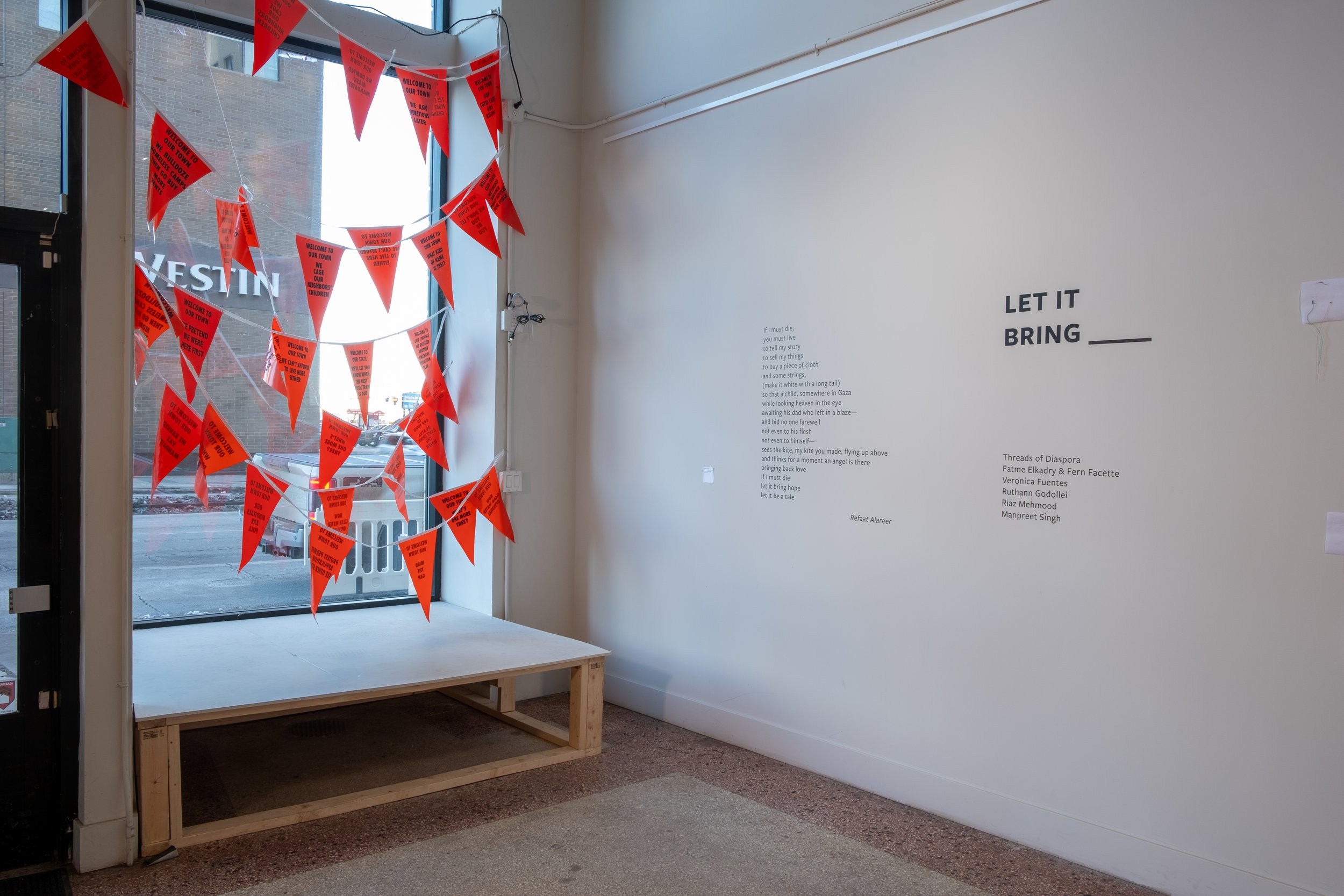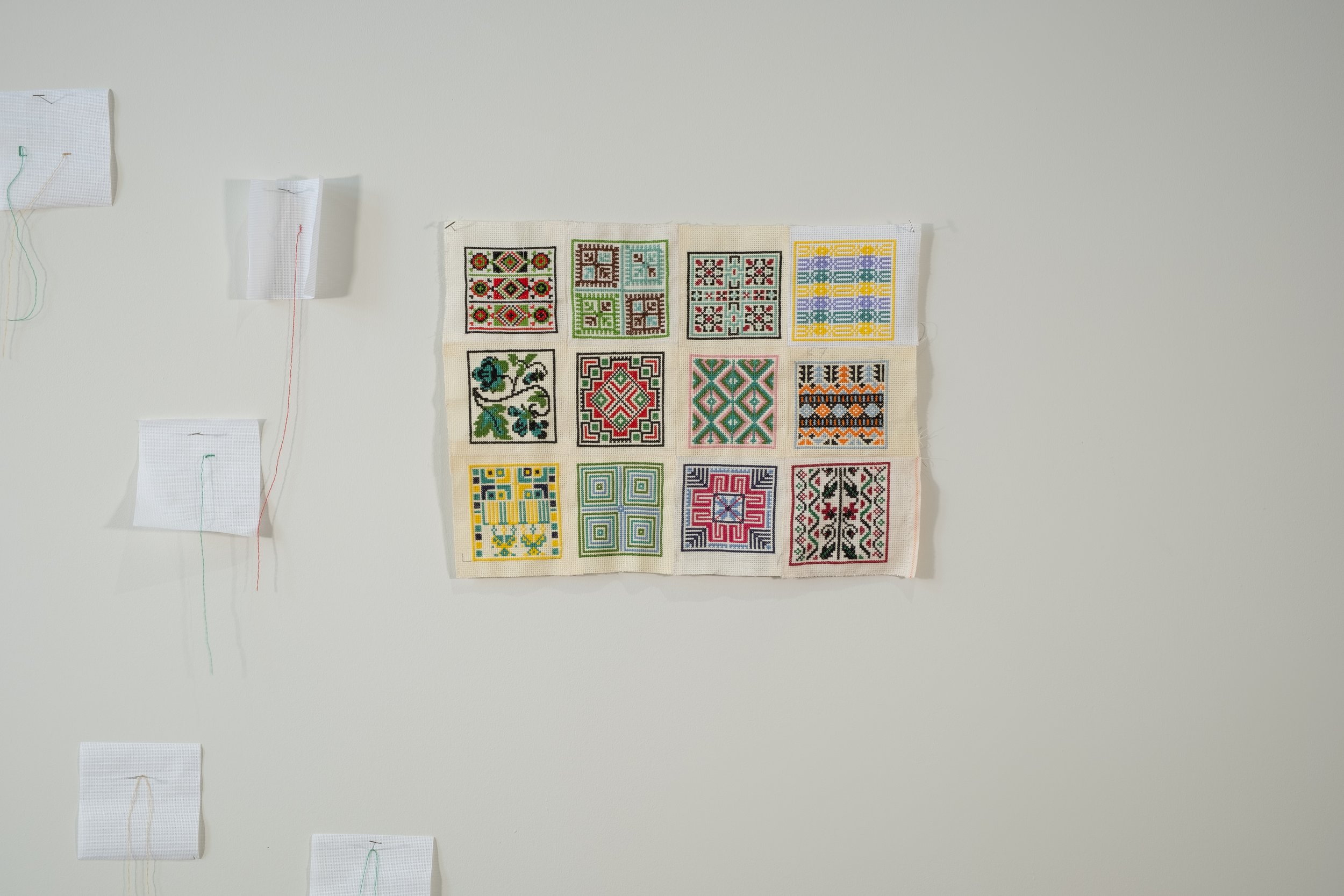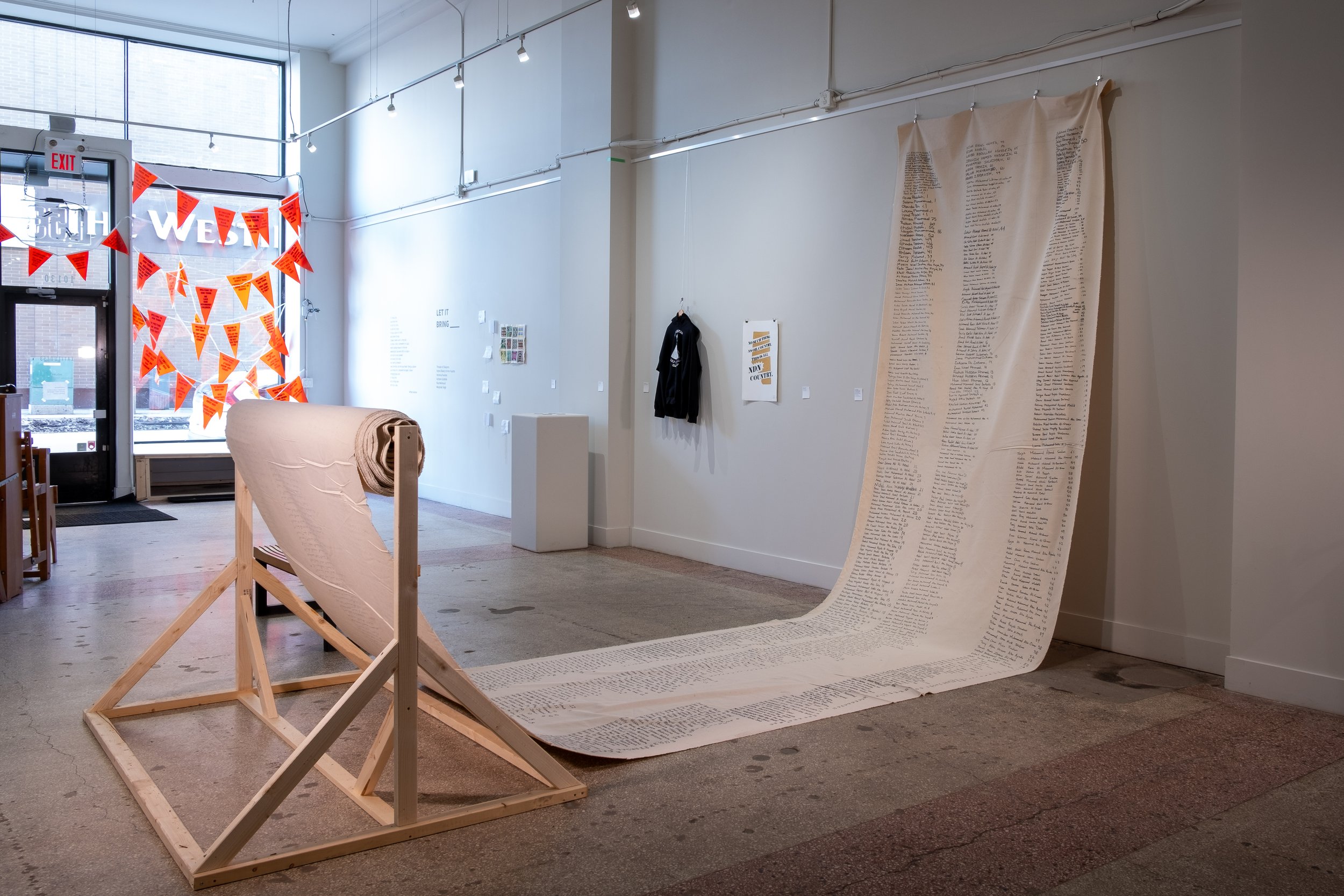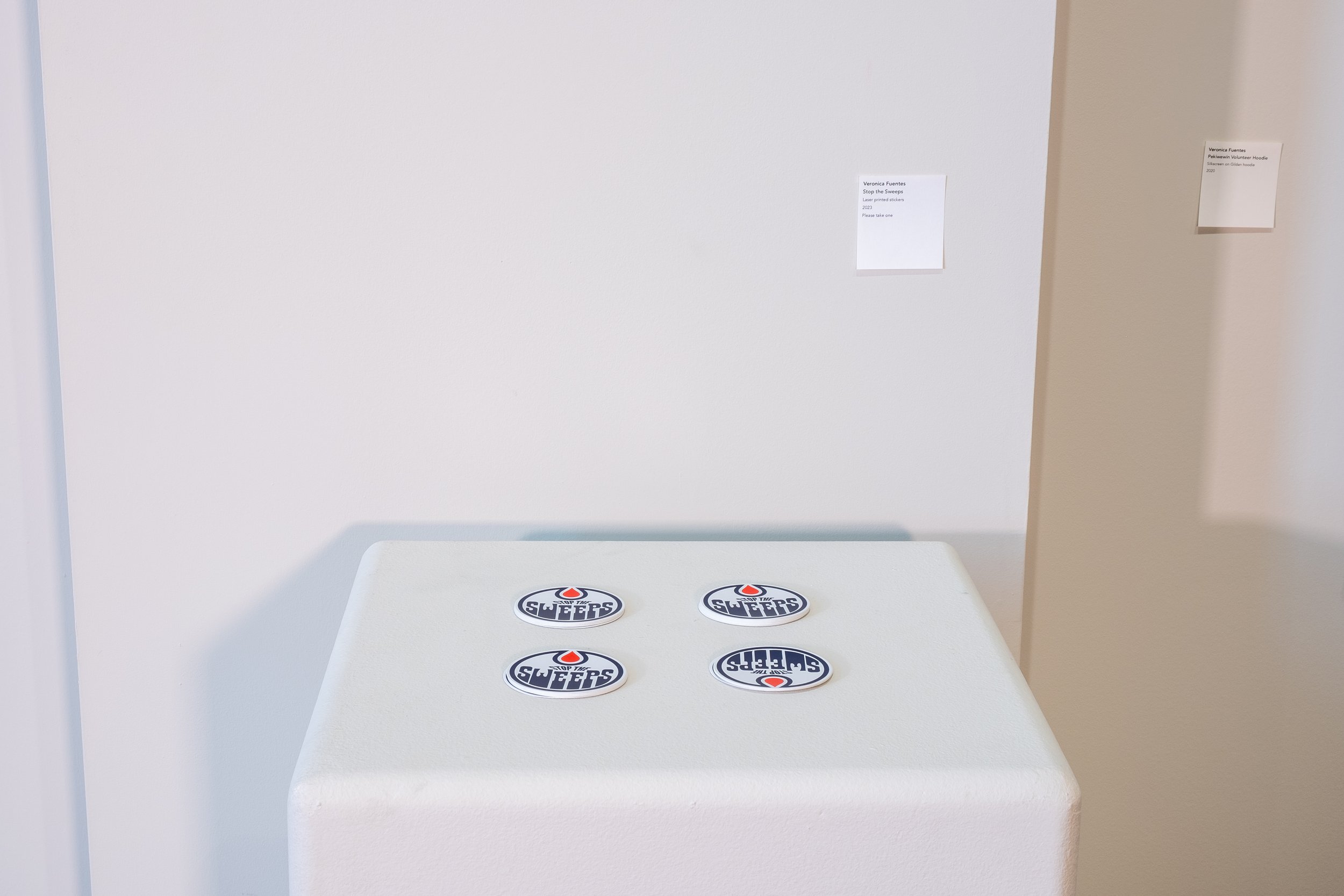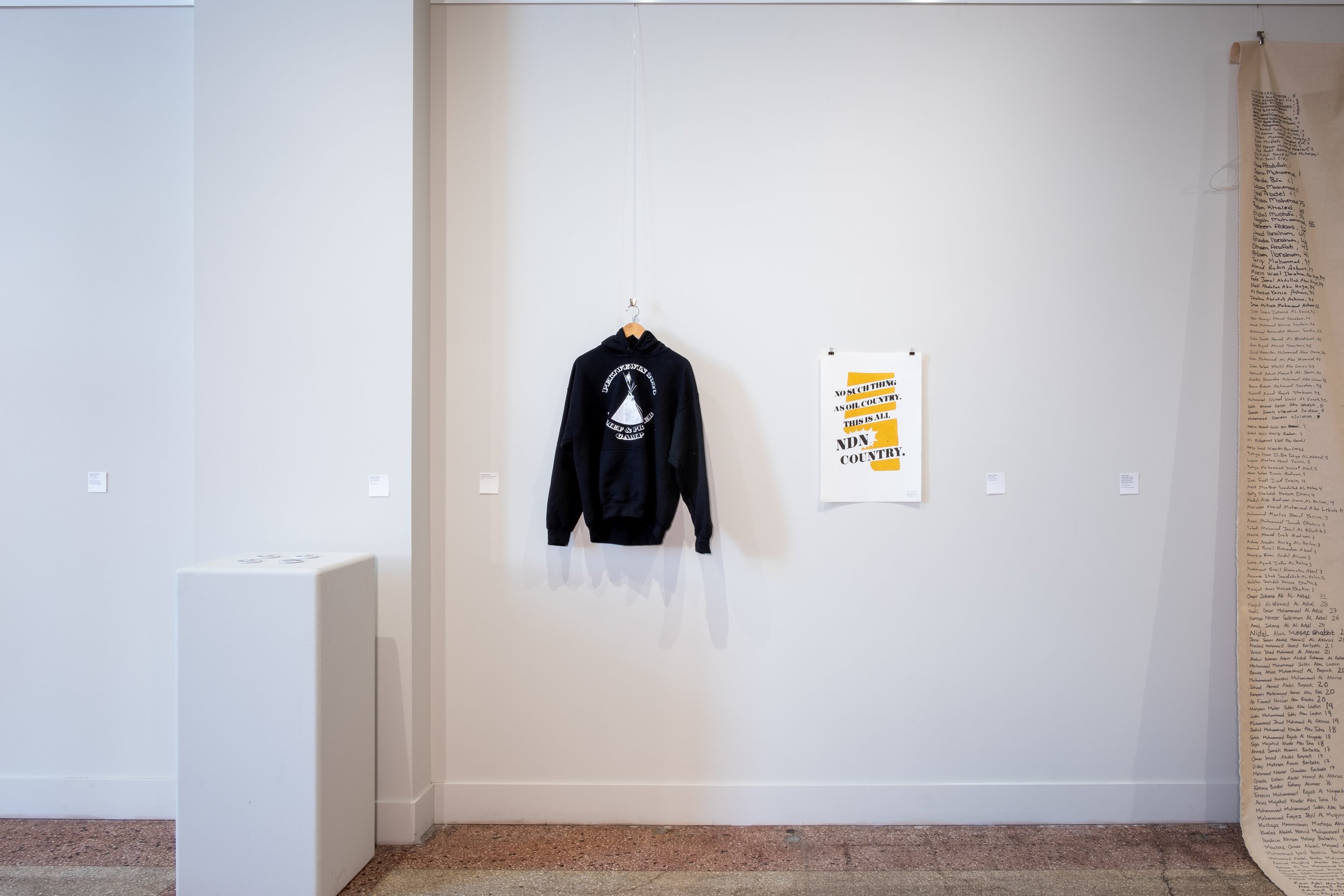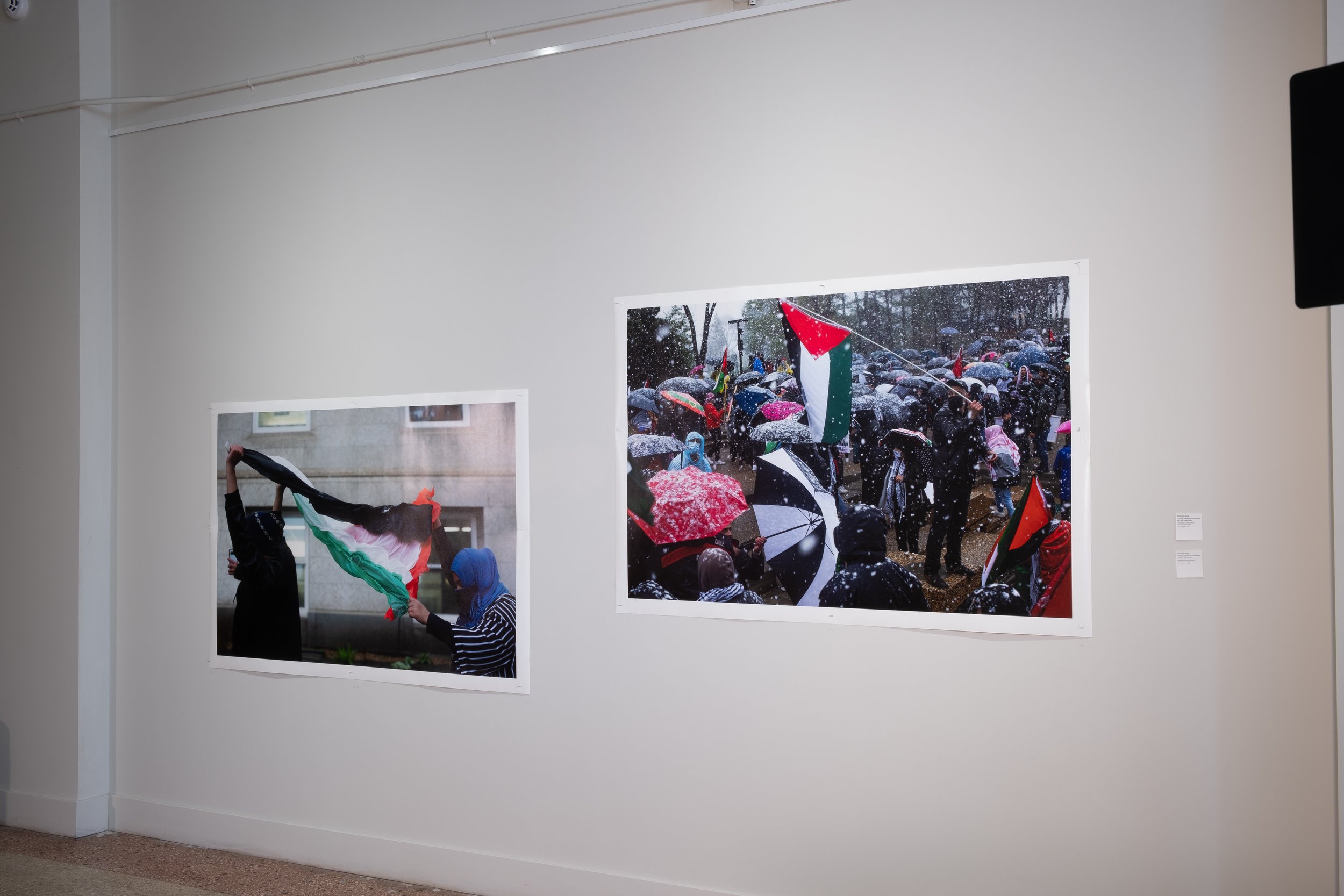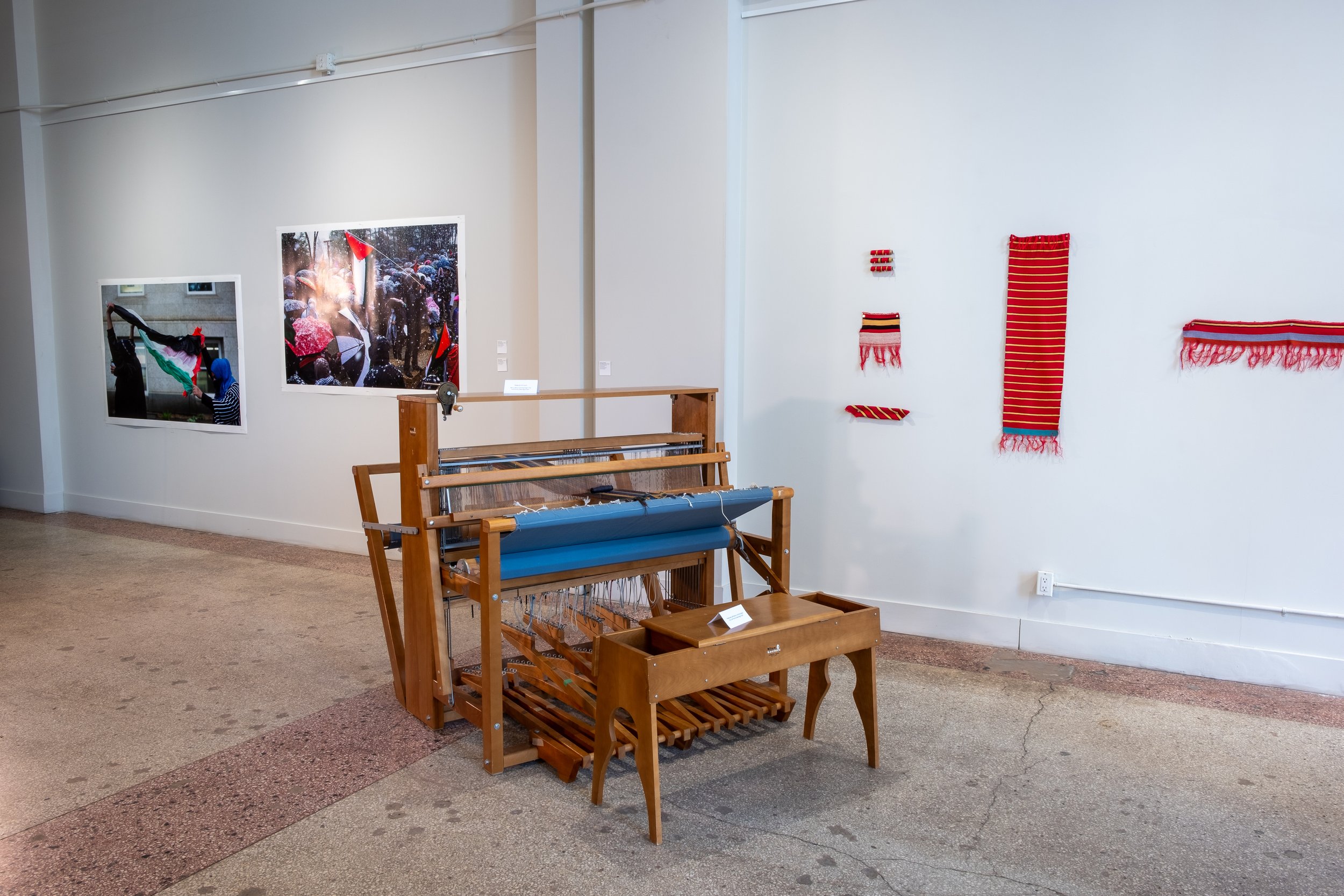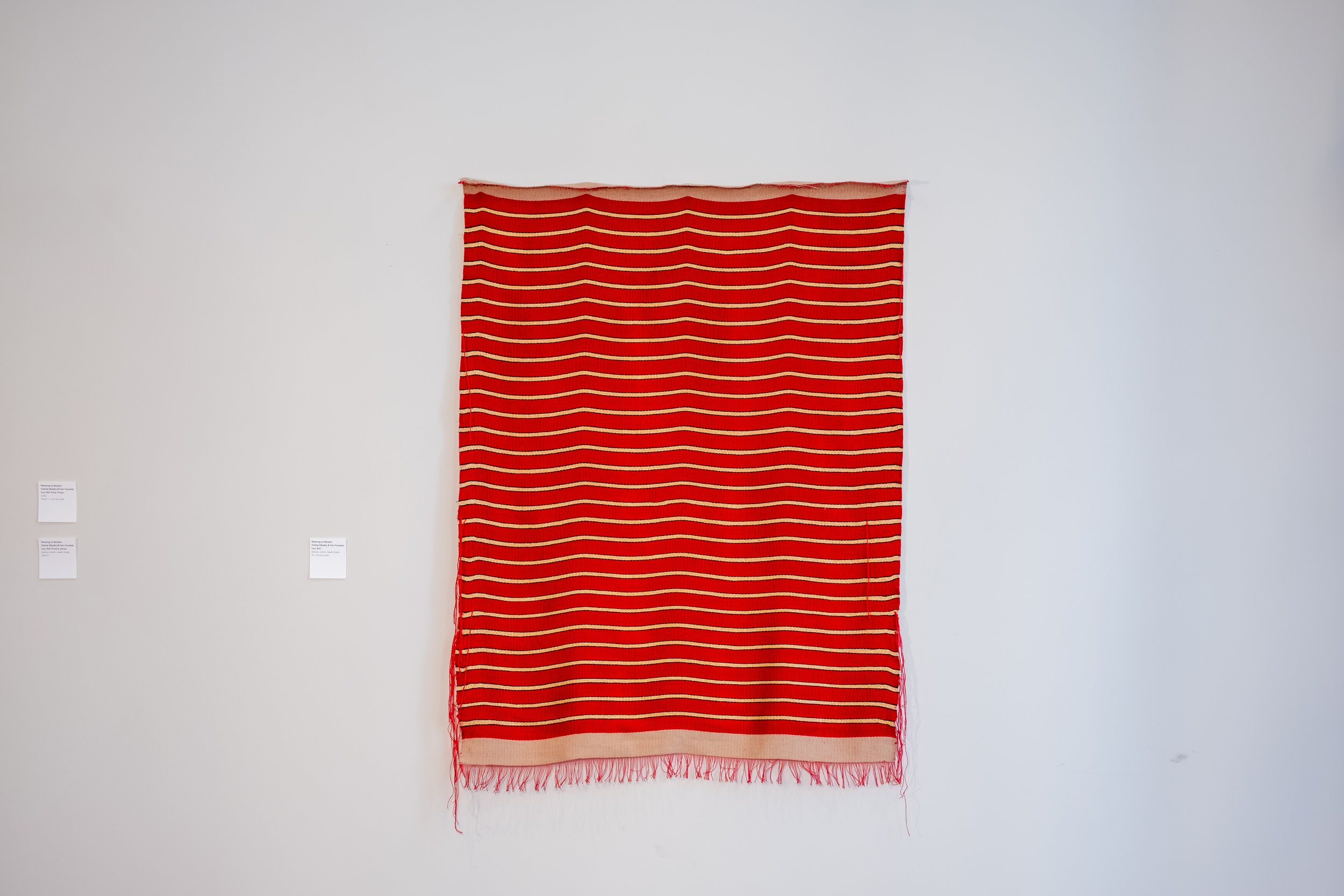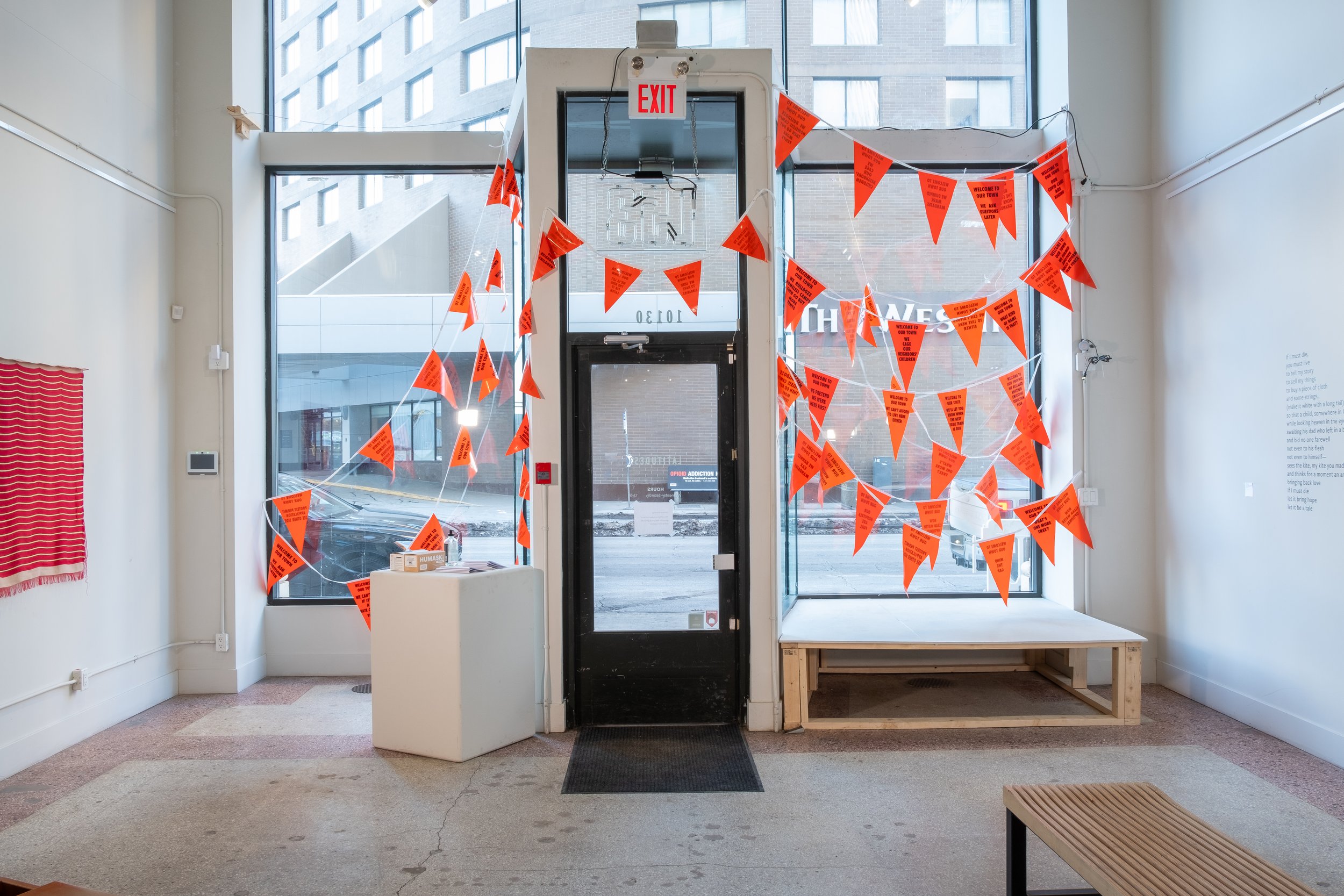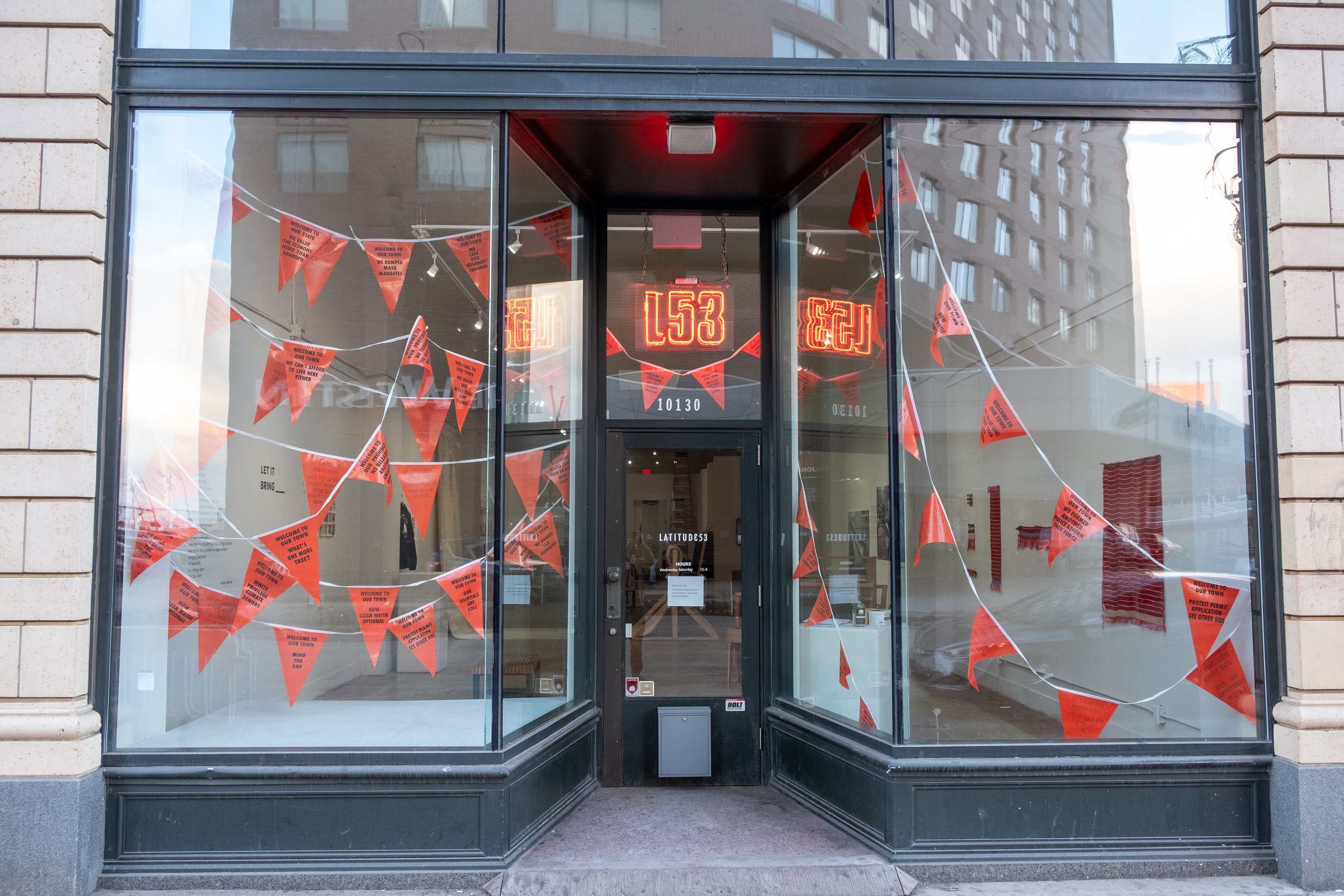Let it bring___
Feb 10–Mar 16, 2024
Closing Reception: March 15, 7-9 PM (Members and guests only event due to capacity)
Content Warning: This exhibit includes themes of Genocide, Martyrs of genocide, War, Palestinian resistance, Land occupation, Protests, and Encampment sweeps.
Workshops: Canvas Patches with Veronica Fuentes - Feb 24, 12-3 PM (drop-in)
Threads of Diaspora: Tatreez Workshop - March 5, 6 PM (registration required)
Riaz Mehmood, Kawtaray/Pigeons, 2020, (video still)
FEATURED ARTISTS
Threads of Diaspora
Fatme Elkadry and Fern Facette
Veronica Fuentes
Ruthann Godollei
Riaz Mehmood
Manpreet Singh
The Question of Funding Collective, a collective of artists and cultural workers, spoke to Elitqa Collective in Gaza about how amidst destruction and desperation, canvases and frames from the gallery were burned for warmth. QOF asks “What is art in the time of genocide?”
Latitude 53 responds to this call by showcasing the work of local Palestinian artists, and artists working in solidarity, speaking out on their experiences with displacement. From the ongoing genocide in Palestine to the unhoused encampment sweeps locally, we turn to art to resist erasure, and support our communities.
The title pays tribute to Palestinian poet Refaat Alareer’s last poem, If I must die. An excerpt:
“If I must die/let it bring hope/let it be a tale”
Veronica Fuentes, Occupation is a Crime, 2023. Banner. Screen printing on canvas, free-handed text.
About the Artists
Threads of Diaspora, a Tatreez project that was born in the heart of Edmonton, Alberta. Created by the Canada Palestine Cultural Association (CPCA), "Threads of Diaspora" stitches our stories and heritage together, reminding us that the whole is greater than the sum of its parts, and each part is already magnificent. Each stitch is like a thread in the tapestry of life, and when combined, they create our beautiful, harmonious, and diversified community.
"Threads of Diaspora" is more than just an art project; it's a cultural movement with a purpose.
Our objectives include:
1. Preserving Heritage: Reviving and preserving the centuries-old Palestinian Tatreez cross-stitch practice, connecting generations through art.
2. Empowering Communities: Creating a nurturing environment where people of all ages can learn and apply new skills, fostering self-empowerment and income generation.
3. Fostering Inclusivity: This project is open to everyone, transcending cultural, religious, and ethnic boundaries. It stands as a powerful symbol against discrimination.
4. Global Collaboration: People from around the world, representing diverse backgrounds, cultures, and religions, are coming together to contribute to this extraordinary art piece.
"Threads of Diaspora" aspires to become an ambassador of peace and unity. We envision it traveling from museum to museum and gallery to gallery, sharing the powerful stories of resilience and unity through art.
About the work
Palestinian embroidery, Tatreez, is a cornerstone of the Palestinian heritage, and its splendor stands out in the Palestinian cultural dresses, Thobes. As a female-led art, Tatreez is a method of self-expression, communication, and representation of womanhood.
The practice of Tatreez originated in Palestine 3000 years ago. A unique form of embroidery that brings together colored threads in various patterns to create traditional motifs. Motifs are area-specific and are the language of distinction between different parts, villages, and cities of Palestine.
The art of Tatreez developed different changes over time to reflect the events that had happened to the Palestinians, which can be seen in the Thobes before 1948 where the motifs and colors specify areas, social and marital status of women, and Thobes in Diaspora where the women in the refugee camps embroider their memories of their homelands on their dresses, then we see Thobes during the first intifada where women changed the motifs into the Palestinian flags and map so they can walk around carrying those symbols on their Thobes without the soldiers being able to take them down as they do with men. Nowadays the Tatreez is being applied to modern designs so Palestinian women can wear them on all occasions and show their pride of their heritage anywhere they go.
Fatme Elkadry (she/her) is a second-generation settler on Amiskwaciwâskahikan from Safad, Palestine. She is a multi-disciplinary artist and has studied visual art, fine craft, graphic design, prose, and performance art through a variety of experiential opportunities, including formal education and personal mentorship. Fatme utilizes her art practice to explore and express her identities. She passionately advocates for barrier-free and equitable involvement of all folks in the arts. Fatme’s favourite things in life are her mama, picking figs with her baba, and magpies.
Fern Facette. Working within the confines of a four-shaft floor loom, Fern’s weaving is an exploration of the infinite possibilities of the grid-like woven structure. Boxes and lines of various colors and textures oscillate throughout her textile designs. Fern’s sculptural handwoven tubes explore broader concepts such as neurodivergence and the role weaving plays within that experience. Fern’s weaving is a nod to weavers’ past and a study of the human relationship to the long-lasting handmade object.
About the work
Weaving to Reclaim is an experimental journey that explores and reclaims diminishing Palestinian heritage, craft, and identity. This work is fueled by a long-term artistic collaboration and mentorship between Fatme Elkadry and Fern Facette. Together, they design and weave textiles that explore the colours, natural dyes, fibres, and motifs of Fatme’s homeland, Palestine. Fern utilizes her weaving skills, honed over decades, to support and mentor Fatme as a new weaver reconnecting with this practice that is ancestral to Fatme’s hometown, but lost due to the catastrophic expulsion of Palestinians in 1948.
Weaving to Reclaim is a four-part series of handwoven studies that explore a variety of traditional Palestinian textiles. Each study incrementally builds to the final piece in the series: a handwoven keffiyeh, a scarf that distinctly symbolizes Palestinian identity.
Inspired by the hand-sewn and hand-embroidered dress Fatme inherited from her grandmother, the second study explores Palestinian clothing. Palestinian dresses are traditionally worn with a striped belt made of handwoven silk, called saya (صايا). In March 2022, Fatme and Fern embarked on weaving a saya belt for Fatme to wear with her grandmother’s dress. Made of cotton, bamboo, and a metallic thread, the colours, and pattern of the piece match the saya belts most commonly worn by Palestinian women.
After continuous refinement, the belt is near completion. The handwoven piece exhibited will be cut and sewn into a saya belt that will be an heirloom for Fatme to preserve and pass down with her grandmother’s dress.
Veronica Fuentes is a mixed Salvadoran and Anishinaabe (Saulteaux). An artist, organizer, direct action trainer, and community helper. She was born and is based out of amiskwaciwâskahikan in Treaty Six Territory. Her role in the community is most centered on areas of harm reduction advocacy, urban Indigenous house-lessness, and intersectional climate justice but she is flexible in her role as a helper. Her deep love for relationships and solidarity within the prairies is paramount to creating art that places itself in Land Back movement(s) in her community, on online platforms, or on the frontlines. Veronica works with multi-disciplinary mediums to express her experiences as an urban, diasporic femme - while also using her creativity to serve community, kin, and her imagination of Indigenous futurisms. Veronica believes that Indigenous peoples have a lot to teach the world about living the way of life we all deserve. In her free time, Veronica can be found scheming creative resistance projects, traditional textile and regalia crafting, printmaking, and working on radio with her friends.
As a creative resistance artist, all my work has been rooted in the storytelling of resurgence and unique, willful resistance. I am not just an artist but a community helper, so I am often working out ways for my art to involve, engage, skill share with the community, and reflect justice-oriented perspectives that are important to me. My art is rarely objective, and often explicitly asserts a message. My collection of items in this exhibition reflects my lived experiences in addition to my involvement in various advocacy projects, direct actions, and what some would call “activism”. These pieces together tell a story of generative refusal, solidarity and the many unapologetic, intellectual Indigenous acts of doing that transform the world around us, all the time.
About the work
6000+ Names of Palestinians killed by Israel from October 7, 2023 - October 26, 2023. November 2023. markers on canvas. Compiled and assembled by artist, Veronica Fuentes and community members for the CPCA,
In early November 2023, a group of Indigenous, Jewish, and settler community members came together to take action in solidarity with Palestine. To publicly grieve the lives of those killed at the hands of the Israeli state, they rolled out a 9-metre strip of canvas in Churchill Square and asked passers-by to contribute by writing out one or more names of those lost to Israel’s genocidal attacks. Some Edmontonians joined to write out the names of family members killed by Israeli bombardments. As the siege of Gaza and bombing continued, the scroll required additional material. The names were copied directly from a list of 6,747 names released by the Gaza Ministry of Health. The scroll eventually grew to be 55 metres in length and still contains only a fraction of the names of all those killed by Israel since October 7th. Today, over 30,000 Palestinians have now been killed by Israel— a number that continues to rise every day.
The piece intends to help people visually process the staggering death toll in Gaza, and convey that every day without a ceasefire and an end to Canada’s complicity in Israeli aggression is resulting in hundreds of more lives killed by Israel. The scroll is unnamed and unfinished. Local Indigenous, Jewish, and settler allies have been the caretakers of this scroll. It is to be given to The Canada Palestine Cultural Association (CPCA).
Stop the Sweeps, 2023. stickers
Stop the Sweeps is a commentary that demands an end to the violent practice of encampment evictions (Sweeps). Stop the Sweeps focuses on the $613.7 million Rogers Place arena, which is the new home for the National Hockey League’s (NHL) Edmonton Oilers, a franchise owned by billionaire Daryl Katz. Stop the Sweeps brings forward the connection between the Ice District, Edmonton Oilers, and Rogers Place - and the gentrification criminalizing, displacing, and un-aliving unhoused city center residents. Stop The Sweeps demands locals see the police violence and banishing of the community that continues to escalate with the reshaping of City Centre Edmonton. Stop The Sweeps was produced into hundreds of stickers to be displayed all over the city
Occupation is a Crime, 2023. Banner. Screen printing on canvas, free-handed text.
Indigenous Peoples in solidarity with Palestine. Occupation is a Crime was made to honor the profound connection between our collective liberation. Indigenous communities advocate for a Free Palestine because Free Palestine is paramount to our Land Back movements. Indigenous peoples are in solidarity with Palestine against the violent, colonial war machines. This banner was made for actions at the UNFCCC, COP28. Dubai, 2023.
"Ndn Country", 2020. Screen printing on cardstock.
Ndn Country was made to assert Indigenous sovereignties in the province often named “Oil Country”. In Alberta, provincial identity is deeply tied to extractive oil and gas industries which depends on the denial of Indigenous jurisdiction over our territories. More specifically, Ndn Country was a response to the 2020 heightened petro-nationalist movement in Alberta, which was led and accompanied by far-right white nationalist groups and delusional Wexit separatists. Indigenous peoples have been here for thousands of years, and we will be here for thousands more - NDN country argues that “Oil Country” culture is illegitimate and untruthful, and that Indigenous Sovereignty comes before any other interpretation of land, resources, and borders.
Pekiwewin Volunteer Hoodie, 2020. Screen printing on Gildan Hoodie.
In the early hours of July 24, 2020, a tipi was erected in the Rossdale Flats of Edmonton, Alberta. The site was developed into a large encampment, supporting residents who were sleeping rough, precariously housed, or houseless. All facing a decline in services due to COVID-19, the City of Edmonton’s negligence, and increased police violence towards encampments. The camp was named Pekiwewin (Nêhiyawewin, the act of coming home). Pekiwewin transformed into an entirely volunteer-run, police-free space of ceremony, harm reduction, 24/7 mutual aid, and leisure. Pekiwewin was sustained until its closure through a letting-go ceremony and round dance ahead of the police eviction on November 12, 2020. Pekiwewin had about 200 tents and roughly 400 city-center residents living within its boundaries. 50 of these hoodies were made as a gift to volunteers for their contributions in sustaining Pekiwewin for 112 days.
Ruthann Godollei creates testimonial objects, bearing witness to the abuses of power. Her work in multiple media incorporates text and found materials to comment on inequities and social issues. Exhibits include Dada Ruht Nicht, The Brandenburgische Landesmuseum für moderne Kunst, Cottbus, Germany, 2024; La Línea: Grupo Soap del Corazón, Plains Museum, Fargo, ND, 2022; The Wish Machine, SNAP, Edmonton, AB Canada 2021; Multiple Ones: Contemporary Perspectives in Print Media, Museum of Contemporary Art, Jacksonville, FL, 2020; North American Screen Print Biennial, 2020; The Big Crash, IMPACT, Biblioteca Central de Cantabria, Santander, Spain, 2018; the 9th Biennale Internationale d’Estampe Contemporaine de Trois-Rivières, Québec, Canada; etc. Her work is in many international collections, including KUMU Museum, Tallinn, Estonia; the Centre For Fine Print Research, Bristol, UK; and the Polish National Museum of Art, Poznañ, among others. She was a Minnesota 2022-'23 McKnight Visual Artist Fellow. Author of a DIY printmaking book, "How to Create Your Own ... " (Voyageur Press), she was the recipient of a 2019 Fulbright Canada Research Chair in Printmaking at the University of Alberta, Edmonton, Canada. She is a Professor of Art at Macalester College in St. Paul, MN, USA and the owner/operator of Printland Press LLC.
About the Work
These orange screen printed orange plastic pennant flags are from a series of "bunting" I made to draw attention to a mindset with which I strongly disagree. A warped version of the 1938 Thornton Wilder play, Our Town, they're meant to function as a kind of chorus, externalizing the thinking which brings us tolerance for gun rights over human rights, extractive practices ruining the planet, putting the economy over human lives and intolerance and persecution of perceived 'others.' What if that quaint, homey Pulitzer Prize -winning play was updated for today's vocally warped chanting of bigotry, nationalism, greed and self interest? There's something deeply wrong in our towns and it's nothing to celebrate.
Riaz Mehmood is a multidisciplinary artist who uses video, photography and computer programming as his primary means of expression. His practice often visits themes of multiple and fluid identities, geographical, psychological and cultural displacement, magic realism, and the development of knowledge. His ancestral home is a small village located between Afghanistan and Pakistan. Riaz immigrated to Canada in 2000 as a professional engineer and decided to pursue a career in the arts. Riaz holds an MFA from the University of Windsor (2012) and completed the Integrated Media program at the Ontario College of Art and Design (2005). He has participated in several international and national artist residencies and workshops, and has earned numerous grants, scholarships, and awards over the years. Riaz has also been involved with several artist-run centers and served on the boards of SAVAC (Toronto) and articule (Montréal). He is currently on the Board of Directors of Latitude. His works have been shown nationally and internationally, including most recently solo exhibitions at the Art Gallery of Alberta and St. Albert Art Gallery.
About the Work
Kawtaray / Pigeons (2020) is a video about memory, dreams, omens and pigeons told in the context of the more than four decades of continuous war in Afghanistan. The video contains five segments. While each segment stands as an independent story, they also overlap and bleed into each other.
Pashtun culture is primarily an oral one; many stories are passed from one generation to another.
The storytelling technique for this video is based on the oral storytelling tradition of the qisago from my tribe. A qisago is not only a storyteller, but also acts as a living archive and a witness for the community. They tell stories of past events in the region. In the qisago’s storytelling sessions, they also include performances of songs by accompanying musicians that interlink and reveal various aspects and events of a narrative.
The folk songs used in this video were recorded during various visits to my village over the years. These songs are laments and express the hardships of displacement, the destruction of ancestral dwellings and waiting for loved ones to return. Just like changing vocal tones uttered in the stories of the quisago, I have used animation, text, still images, found footage and regional folk songs to connect and reveal different aspects of the war and its devastating effects on the Pashtun people of the region.
This video is a part of the body of work that looks at acts of memory or remembrance as a form of resistance, specifically if it is a shared memory of a community that faces organized efforts to delegitimize their memories and stories.
Manpreet Singh arrived in Amiskwaciwâskahikan from North India to study Bachelor of Design at University of Alberta from where he graduated in 2022. He has honed his skills in photo documentation by crafting intricate conversations through visuals with emphasis on composition and light, weaving photographic memories through detail oriented approach and emotional engagement. Presently, he is using photography and film-making skills to document alternative paradigms of knowledge, seeing the land as history and being witness to the moments leading to its transformation.
About the Work
These photographs are from the protests representing the public of Edmonton in solidarity with the Palestinians. Coming from India, I have understood protests as one of those key moments of social solidarity that lead to transformation of the socio-political landscapes historically. To come together as a community in the times of crisis leaves an imprint for the public memory when communities need examples to draw from in order to stand strong amidst pain and suffering. Photographing protests while walking among the protestors also sheds light on how the colours, the costumes and textiles, and the slogan designs carry knowledges from the counter memories.
